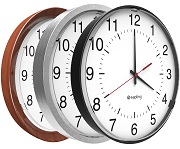Virtually every enterprise can benefit from synchronized time displays, clocks that all display the same correct time. But which system is best for your organization?
There are many options to pick from, depending on your industry and the number of displays required, but which system is best for your organization?
Large Environments
Small Environment/Office
For smaller facilities such as a small office, medical clinics, an investment in a master controller may not be warranted. In that case, Power over Ethernet (PoE) or Wi-Fi Network Clocks may be a better option.These clocks can connect to your master clock, or any other NTP time source, within your environment to ensure they all display the same time.
Upgrading an existing system
Many education facilities have pre-existing Sync-Wire clock systems. Some of the clocks may be failing, or the clock controller is not functioning correctly.For this we have a couple of options.
Sapling clocks are compatible with most name brand controllers, which allows you to directly replace your clocks. One of the disadvantages of a sync-wire system is the frequency of the time sync which is once every 12 hours. This means that in the event of a power outage or when adding or replacing clocks, it could take up to 12 hours for the clocks to display the correct time.
If your clock controller is failing or you would like to upgrade, you can install a hybrid master clock with a wireless transmitter that also supports your existing wired clocks. This is a cost effective option as you can upgrade your wired clocks to the newer wireless clocks as the older clocks fail or budget becomes available.
Clock Selection
Once you’ve selected your clock system, you’ll need to decide between analog and digital displays. Analog clocks may be designed with images or a logo and different sizes which makes them a good fit for waiting areas or other customer facing locations, whereas the brightness of digital clocks is helpful in places with low light areas.
Digital clocks can also come with enhanced functionality, such as an elapsed-timer that allows you to track how much time has gone by during a specific task. This can prove useful for meetings, timing events or time sensitive events like code blue in a hospital environment.
Clocks that Keep Everyone Safe and Informed
Your synchronized digital clocks can now do so much more, by bringing visual notifications to your facility especially in busy noisy environments. The OnAlert system is an advanced, powerful communication platform that during normal operation can present time of day but can be switched to a high priority message which replaces all other messages during times of crisis.
Considering your options contact us to discuss which is best for you






